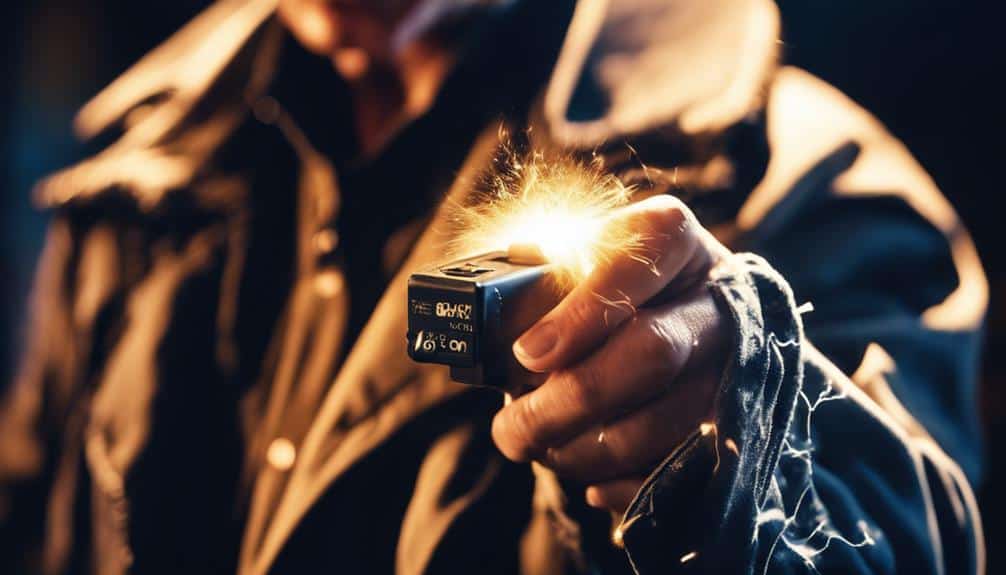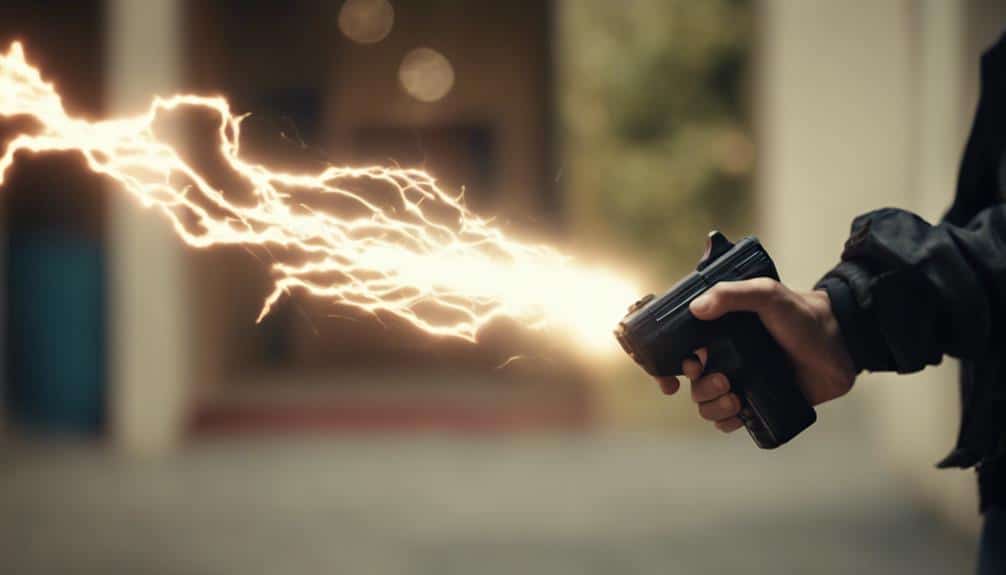If you’re wondering whether a
stun gun has to touch skin, the answer’s pretty much yes for it to be super effective. While a jolt through
light clothing might work,
direct contact with skin packs a bigger punch. Think of it as trying to tickle someone through a wool sweater—not so easy! Aim for spots with less clothing, like the shoulders or chest, for the
best results. It’s like giving a high five: without touching, it’s just air! Want to find out more about how these zappy devices work and when to use them? Just keep going!
Understanding Stun Guns
Understanding
stun guns begins with knowing how they operate. These devices deliver
high-voltage,
low-amperage electrical charges to disrupt the nervous system. For maximum stun gun effectiveness, you need
direct skin contact. It’s like trying to water a garden through a tarp—thick clothing can diminish the charge’s impact. So, aiming for areas like the shoulders, back, or chest where there’s less barrier is key. Additionally, choosing a
compact model with an internal rechargeable battery can enhance convenience and reliability.
When you press the stun gun directly to the skin, the
electrical current effectively targets large muscle groups, causing
temporary incapacitation. Picture a lightning bolt to the system—it’s not about knocking someone out cold, but rather causing enough pain to make them stop in their tracks. Light clothing? No problem! But remember, direct contact is your best bet. Hold the device there for at least 3 to 5 seconds to guarantee it does its job.
Using a stun gun isn’t just about zapping away. You’ve got to understand its
proper application for it to be an effective
self-defense tool. So, the next time you think about stun guns, remember, it’s all about that shocking direct skin contact!
Mechanism of Action
When you’re using a
stun gun,
high voltage packs a punch, sending a shock that disrupts the attacker’s nervous system and muscles. While some stun guns can zap through light clothing, touching skin makes it way more effective, kind of like the difference between a gentle nudge and a firm shove. For instance, the
Stun Pen Pink Stun Gun boasts
40 million volts of electrical power, ensuring a substantial impact. You’ve got to keep it pressed against them for at least 3 to 5 seconds, aiming for
big muscle groups like the chest or back, to really make them regret messing with you!
High Voltage Impact
A
stun gun‘s
high-voltage impact works by directly disrupting the target’s
nervous system, leading to rapid and uncontrollable
muscle contractions. When you use a stun gun, it sends a high-voltage electrical charge through the body, which can be incredibly jarring. Imagine suddenly having all your muscles contract at once—it’s like the worst charley horse you’ve ever had, multiplied by a hundred. The
SAL Pink Stun Gun provides a powerful
95,000,000 volts to guarantee maximum disruption. Additionally, features like a
built-in 120-lumen flashlight and a 120 dB alarm add layers of security.
For the stun gun to work effectively, it needs
direct contact with the skin. This is because the electrical charge travels best through less resistant surfaces, making sure it reaches the nervous system quickly. Think of it like trying to water a plant through a thick plastic sheet—it’s just not going to get through as well.
The high voltage—ranging from 50,000 to 300,000 volts—targets large muscle groups to maximize impact. Picture touching a live wire and feeling that sharp jolt; it’s similar but designed to incapacitate temporarily. This immediate effect can be essential in
self-defense situations, giving you precious moments to escape.
Clothing Penetration Ability
Although a
stun gun’s effectiveness is maximized with
direct skin contact, it can still deliver a
jarring shock through clothing. This high voltage stun device has a notable
clothing penetration ability, meaning it can zap through common fabrics. However, it’s important to remember that not all clothes are created equal when it comes to getting stunned. Light clothing, like a T-shirt or a thin sweater, doesn’t stand much chance against a
high voltage stun gun. But if you’re dealing with
thicker materials, like a heavy coat or layered outfits, the stun gun might need a bit more oomph to be effective. For the best results, aim for areas with less clothing, like the shoulders or chest—this increases the odds of
effective incapacitation.
Synthetic fabrics, like polyester, usually offer less resistance compared to natural fibers like cotton. So, if you’re planning to use a stun gun for self-defense, knowing a bit about your target’s wardrobe might be more useful than you’d think. The stun gun’s ability to penetrate clothing isn’t perfect, but it’s pretty impressive. That said, keep in mind that direct skin contact always guarantees the best energy transfer and
maximum shock.
Contact Duration Effectiveness
Understanding how clothing impacts a stun gun’s effectiveness is just one part of the equation; equally important is the duration of contact. When you press a stun gun against an attacker, you need to hold it there for at least 3 seconds. Why? Because that’s how long it takes to deliver an effective electrical current that disrupts their muscle function and causes incapacitation. If you just tap them quickly, it might not do much, especially if they’re wearing thick clothing.
Direct skin contact is your best bet, as it guarantees the most efficient energy transfer. But don’t worry if they’re wearing clothes—just keep the stun gun pressed firmly. The effectiveness of the stun gun increases with sustained contact, typically between 3 to 5 seconds. This duration can cause muscle lock-up and serious disorientation, giving you the chance to escape.
Here’s a quick look at how contact duration affects effectiveness:
| Duration (Seconds) |
Effectiveness Level |
Result |
| 1 |
Low |
Minor pain, minimal incapacitation |
| 2 |
Moderate |
Increased pain, some muscle control loss |
| 3 |
High |
Pain compliance, possible muscle lock-up |
| 4-5 |
Maximum |
Full muscle lock-up, severe disorientation |
Electrical Charge Delivery
When it comes to using a
stun gun, you might wonder if it has to touch skin to work effectively. The good news is, it doesn’t always need direct skin contact; stun guns can deliver a shock through
common clothing, although thicker materials might reduce their punch. The
LiL Guy Pink Stun Gun, with its compact design and powerful 60 million volts, is particularly
effective in ensuring
personal safety. For the best results, keep the stun gun pressed against the attacker for 3-5 seconds, and aim for spots with less clothing, like the neck or chest, to really pack a wallop and stop them in their tracks.
Clothing Penetration Factors
The effectiveness of stun guns hinges on their ability to deliver an electrical charge despite the barriers posed by clothing. You might wonder, “Can these devices really work through layers of fabric?” The answer is yes, but it depends on several factors. Clothing penetration is an essential aspect to take into account. Thin fabrics like cotton tees allow the electrical charge to pass through more easily, making them an effective means for the stun gun to work. However, thick materials like leather jackets might require a higher voltage for the shock to be as effective.
Here’s a quick look at how different fabrics affect
stun gun effectiveness:
| Fabric Type |
Effectiveness |
| Thin Cotton T-shirt |
High |
| Denim Jeans |
Moderate |
| Leather Jacket |
Low |
| Wool Sweater |
Moderate |
| Heavy Winter Coat |
Very Low |
High-voltage stun guns can penetrate most common clothing types, but for best results, aim for large muscle areas like the chest or back. Direct skin contact is ideal, yet not always possible, so understanding clothing penetration can help you use your stun gun more effectively. Don’t forget, sustained contact for a few seconds makes a big difference!
Contact Duration Impact
Duration is essential when using a
stun gun effectively. When you use a stun gun, the contact
duration directly impacts how well the
electrical charge works. A brief zap might startle someone, but it won’t do much to
incapacitate them. You need to keep the stun gun pressed against the skin for at least 3 to 5 seconds for it to really take effect. This contact duration is critical because it allows the electrical charge to penetrate deeply, disrupting
muscle function and causing temporary lock-up.
Given the
1 million volts of power delivered by devices like the ZAP Stun Cane with Flashlight, maintaining contact is even more significant to guarantee
maximum effectiveness. Imagine you’re in a
high-stress situation, your heart is racing, and you need to defend yourself. Holding the stun gun against an attacker for a few seconds might feel like an eternity, but it’s necessary to make sure the electrical charge does its job. The longer you maintain contact, the more effective the stun gun becomes. It’s not just about delivering a shock; it’s about assuring the electrical charge has enough time to spread through the muscles and nerves.
Contact Requirements
Achieving the
maximum effectiveness of a stun gun hinges on
direct contact with the target’s skin. When you consider stun guns, direct contact guarantees the
electrical charge penetrates effectively, causing the desired
incapacitating effect. If you want that zap to really count, aiming at
large muscle groups like the shoulders, back, or chest is your best bet. These areas allow for better energy transfer and pain compliance, making the target more likely to be immobilized.
Now, envision this: you’re in a situation where you need to defend yourself. You whip out your trusty stun gun and aim. Hitting bare skin is ideal because it lets the electrical charge do its thing.
Thicker clothing? Not so much. While high-voltage stun guns can sometimes get through lighter fabrics, thicker materials can seriously dampen the shock’s power. So, if you want to make your stun gun as effective as possible, direct
skin contact is the way to go.
And don’t forget—keeping that contact for at least
3-5 seconds can make a huge difference. This duration helps guarantee the target is incapacitated, giving you precious time to escape or call for help.
Effectiveness Through Clothing
You might be wondering if a
stun gun will work
through clothing, and the short answer is yes, but it depends. Thin fabrics won’t pose much of a problem, and the
high voltage can easily zap through, but
thicker clothing like heavy jackets can make things trickier. So, if you want to be sure it works, aim for areas with less clothing and keep that contact steady! Additionally, using a stun gun with a high voltage like the
100 Million volt Bouncer can increase its effectiveness through thicker materials. Always remember to maintain a firm grip, as many models come with a rubber handle designed specifically for this purpose.
Clothing Thickness Impact
When it comes to the
effectiveness of stun guns through clothing, the
thickness of the fabric plays an essential role. If you’re trying to use a stun gun, remember that voltage is key.
Higher voltage can help the electrical charge penetrate thicker clothing. For instance, the
Triad 27,000,000 Volts Stun Gun offers a higher voltage for
better penetration. But, if you’re up against a thick winter coat, even a powerful stun gun might struggle a bit.
Picture this: it’s a chilly evening, and someone’s wearing a
heavy jacket. Your stun gun might not be as effective because the clothing thickness acts like a shield, dampening the impact. Lighter clothes, like a t-shirt or a thin blouse, are much less of a barrier, allowing the electrical charge to pass through more easily.
For best results, aim for
sustained contact—at least 3 to 5 seconds. This helps the charge do its job, even through layers. Of course,
direct skin contact is always the most effective, but we all know that’s not always possible. So, if you’re relying on a stun gun for
self-defense, keep in mind that your target’s clothing can make a big difference. It’s a good idea to know your device’s limits and capabilities before you need it.
Voltage Vs. Material
The
effectiveness of a stun gun largely hinges on the interplay between
voltage and the
material of the target’s clothing. Imagine you’re out in the cold, bundled up in layers. A high-voltage stun gun might still get through, but it’s going to work a lot harder than if you were just in a t-shirt.
Clothing thickness really plays a big part in how well that
electrical shock is going to hit home.
High voltage means the stun gun can push its way through lighter clothes more easily. So, if someone’s wearing a thin shirt, the shock might feel like a lightning bolt. But thicker materials, like a heavy jacket, offer more
resistance. If you choose a model like the
Triad Pink Stun Gun, which delivers a high-voltage shock of 27,000,000 volts, you can expect it to perform better through various clothing layers. The charge might not be as effective, and you’d need to focus on areas where the clothing isn’t as thick.
Direct skin contact is always the best for the strongest zap. But, since that’s not always possible, aiming for spots with less clothing thickness can help. Remember, even if you’re dealing with thick clothing, a stun gun with high voltage can still pack a punch. It just might need a bit more time to really do its job.
Contact Duration Matters
While high voltage helps a stun gun push through various layers of clothing, the duration of contact plays an equally significant role in its effectiveness. You might think zapping someone for a split second is enough, but it’s really not. Holding the stun gun against them for 3-5 seconds makes a world of difference. This extended contact duration guarantees that the electrical current has enough time to disrupt the attacker’s nervous system, making them more likely to be incapacitated.
Even if you’re dealing with thick clothing, keeping the stun gun pressed against the target for those vital seconds can still deliver a good jolt. However, for the best results, direct skin contact is ideal. Here’s why:
- Thicker clothing: Requires higher voltage to penetrate, reducing the stun gun’s effectiveness.
- Light clothing: Offers less resistance, making the stun gun more effective.
- 3-5 seconds: Increases the likelihood of incapacitating the target.
- Electrical current: Needs time to affect the nervous system.
- Direct skin contact: Delivers the most effective shock.
Imagine trying to scare off a bear with a flashlight; a quick flash might not do much but keeping the beam steady could make it think twice. So, remember, in a tight spot, hold that stun gun steady for those few extra seconds.
Types of Stun Guns
You’ll find that
stun guns come in a variety of forms, each tailored to different
self-defense needs. These devices use an
electric current to
incapacitate attackers, giving you precious time to escape. Let’s explore the types of stun guns you might consider.
First up, mini stun guns. They’re
compact and easily portable, perfect for carrying in your purse or pocket. Despite their size, they pack a punch, delivering a strong electric shock to fend off threats. If you’re looking for something discreet and effective, this might be your go-to.
Next,
flashlight stun guns. These are like Swiss Army knives for self-defense. Not only do they light your way in the dark, but they also double as a stun gun. So, when a potential attacker approaches, you can blind them with light and zap them with a shock. Talk about
multitasking!
And then there’s baton stun guns. Imagine a baton that can also deliver an electric shock. You can strike an assailant while simultaneously incapacitating them. This dual-action tool is perfect for those who want a bit more reach and impact.
In any case, these stun guns offer diverse ways to
protect yourself effectively.
Legal Considerations
Maneuvering the legal landscape of stun gun ownership can be tricky, but it’s important for staying compliant and safe. When it comes to stun guns, you can’t just buy one and call it a day. You’ve got to take into account the legalities in your state. For instance, in Massachusetts, you need a License to Carry (LTC) to purchase one from a licensed firearms dealer.
Here are some key legal considerations you should keep in mind:
- Age Requirements: Most states set the legal age for stun gun ownership at 18, but this can vary.
- Permits and Registration: Some states may require you to get a permit or register your stun gun.
- Location Restrictions: There may be places where carrying a stun gun is off-limits, like schools or government buildings.
- Responsible Usage: Knowing when and how you can legally use a stun gun for self-defense is essential to avoid legal trouble.
- State-Specific Regulations: Each state has its own rules, so it’s important to understand the laws in your area.
Safety Precautions
When using a
stun gun for
self-defense, taking proper
safety precautions is vital to confirm both effectiveness and legal compliance. First, always
familiarize yourself with your stun gun’s operation. Knowing how it works guarantees you can use it quickly when needed, and that’s significant in an emergency. Next, keep your stun gun
easily accessible. Storing it in a hard-to-reach spot defeats the purpose if you’re facing
immediate danger.
Maintaining the device is another key safety measure. Regularly check the battery because a low battery can cripple its peak performance. Imagine needing it and hearing just a weak spark—now that’s a nightmare! Also, inspect the stun gun for any damage or malfunction. You don’t want it failing when things get dicey.
Remember, stun guns are self-defense tools. You should only use them when you’re in immediate danger. Misusing one can land you in hot water legally, and that’s a headache you don’t need.
Lastly,
practice makes perfect. Regular drills will help you stay calm and composed when it really counts. With these safety measures, you’re better prepared to protect yourself effectively and responsibly.
Targeting Techniques
Getting the most out of your stun gun in a self-defense situation boils down to mastering targeting techniques. When you’re in a pinch, knowing where to aim can make all the difference. Stun guns work best when they touch the skin directly, delivering an electrical current that causes muscle contractions, leading to temporary incapacitation.
To maximize your stun gun’s effectiveness, aim for large muscle groups, like the shoulders, back, and chest. These areas are more likely to result in the muscle contractions needed to immobilize your attacker. Here are a few pointers to keep in mind:
- Large muscle groups: The shoulders, back, and chest are prime targets.
- Sustained contact: Hold the stun gun against the target for 3 to 5 seconds.
- Clothing considerations: Light clothing is okay, but thick materials might need higher voltage.
- Optimal areas: Aim for spots with less clothing, like between the neck and waist.
- Quick assessment: Be ready to adjust your aim based on the target’s clothing and movement.
Alternatives to Stun Guns
Exploring alternatives to stun guns opens up a variety of
self-defense options that cater to different needs and preferences. You might find
pepper spray to be a fantastic choice. It’s legal in all 50 states and can disrupt an attacker’s vision from a distance, giving you a critical edge. Imagine having that peace of mind in your pocket!
Now, how about
keychain weapons? These nifty little tools enhance your hand strikes and are super convenient for everyday carry. They’re like a secret weapon dangling from your keys, ready when you need them.
Personal alarms are another great option. These devices emit
loud noises to distract attackers and alert bystanders, increasing your chances of getting help. Picture yourself in a sticky situation; a high-pitched alarm could be just what you need to turn heads and scare off an attacker.
Tactical tools like whips and monkey fists are also worth considering. They require
minimal strength and can be used from afar, offering self-defense without the need for close contact. Ultimately,
mobile safety apps equipped with
GPS tracking and SOS capabilities can enhance your safety, alerting authorities during emergencies. So, keep exploring and find what fits your lifestyle best!
Frequently Asked Questions
Do You Have to Make Contact Stun Gun?
You have to make contact with a stun gun for it to work effectively. For ideal stun gun effectiveness, follow safety precautions and self defense tips, ensuring direct contact with large muscle groups and maintaining contact for 3-5 seconds.
You need to know that stun guns require direct contact for effectiveness, ensuring safe use. Meanwhile, TASERs fire projectiles up to 15 feet, providing a broader range. Both are essential self-defense tools, but TASERs offer greater incapacitation.
Do Tasers Work Through Jeans?
Yes, tasers work through jeans, but the stun gun’s effectiveness depends on the clothing material and the voltage impact. High-voltage models penetrate better, but direct skin contact is always more effective. Aim for thinner clothing areas for best results.
Does a Taser Gun Go Into Your Skin?
You might wonder if a Taser gun goes into your skin. Rest assured, it doesn’t. For taser safety, these devices deploy barbed probes that bypass electrical resistance, ensuring stun gun effectiveness without needing direct skin contact.










One Response